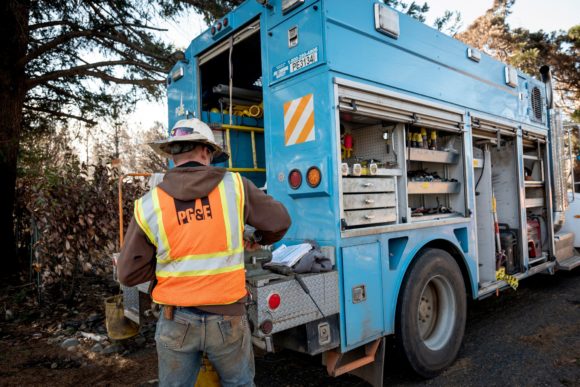It was on July 12 — only after an inspector raised the alarm — that PG&E Corp. finally pruned a tree in a fire-prone area. Its leaves had already been singed as wind gusts blew them into a power line inches away.
PG&E had first flagged the tree for maintenance back in November. Months went by before one of the bankrupt utility’s tree-trimming contractors certified in February — falsely as it turns out — that the work was complete. In April, a “pre-inspector” prescribed the tree for work, but failed to note that it was urgent.
That anecdote was detailed — with an accompanying photo of the tree, but no information about its location — in a report issued Wednesday about PG&E’s progress in making Northern California’s grid as safe as possible for fire season. That’s after a deadly series of blazes devastated parts of California in 2017 and 2018, saddling the San Francisco-based company with an estimated $30 billion worth of liabilities and forcing it into bankruptcy.
The outside compliance monitor found that PG&E is overlooking high-risk trees, isn’t training its contractors properly and is failing to keep adequate records. That may create new trouble for the embattled utility with the federal judge overseeing its probation for multiple felony convictions in 2016 over shoddy record keeping for its natural-gas operations.
PG&E shares tumbled as much as 11% on Thursday, hitting their lowest level in six months. The stock was down 7% to $14.80 at 11:40 a.m. in New York.
The report risks infuriating U.S. District Judge William Alsup, who has repeatedly admonished PG&E over its failures and recklessness, and strained to arrive at a punishment that will spur the company to strengthen its fire-prevention efforts. That the court-appointed monitor has uncovered hazards PG&E arguably should have found on its own doesn’t bode well for the utility, or Bill Johnson, its new chief executive officer, at a Sept. 17 hearing before Alsup.
Meanwhile, PG&E is fighting keep control over its bankruptcy proceeding. A judge is expected to rule in the next few days on whether a group of bondholders can compete with PG&E in proposing a plan to restructure the company.
The company said it shares the monitor’s concerns about wildfire risk.
“PG&E’s service area includes more than 120 million trees with the potential to grow or fall into our overhead power lines,” PG&E said in a statement. “While we have made progress in many areas to further enhance wildfire safety including vegetation-management work, we acknowledge that we have more work to do.”
This year, PG&E said it has embarked on a plan to step up its tree trimming in high-fire risk areas spanning 25,000 miles of power lines as part of a multibillion-dollar wildfire safety plan.
The monitor, Mark Filip, is reviewing those efforts. After the company’s 2016 conviction stemming from a gas pipeline blast that killed eight people, Filip’s job is to ensure PG&E doesn’t violate the terms of its probation and to scrutinize its business practices more broadly.
Filip’s role has grown as PG&E’s equipment has been found culpable for igniting wildfires that scorched swaths of northern California and killed residents in recent years. The utility is under criminal investigation in Butte County, where the Camp Fire, which raged for two weeks in November, destroyed the town of Paradise, killing 86 people. Lawsuits over the loss of life and damage caused by the Camp Fire and others before it precipitated PG&E’s filing for bankruptcy.
Filip said in his report to Alsup that he uncovered “significant, actionable findings.”
Inspections are “not only revealing individual trees that are missed, including three active wildfire threats in high-risk areas, but they also reflect gaps in processes, for example, contractor training,” the monitor said.
The monitor noted that five of PG&E’s felony convictions from the 2016 trial “related to record-keeping defects concerning its gas operations.”
PG&E told the monitor it took remedial steps after the July 12 pruning. The tree trimmer who falsely said the work had been done was banned from working on PG&E lines. Also, the utility pledged to review his prior work and that of the pre-inspector who didn’t flag the tree as an urgent priority, according to Filip’s report.
The case is U.S. v. Pacific Gas and Electric Co., 14-cr-00175, U.S. District Court, Northern District of California (San Francisco).
–With assistance from Mark Chediak.
Was this article valuable?
Here are more articles you may enjoy.


 OpenAI And Microsoft Sued Over Murder-Suicide Blamed on ChatGPT
OpenAI And Microsoft Sued Over Murder-Suicide Blamed on ChatGPT  Musk’s xAI Faces California AG Probe Over Grok Sexual Images
Musk’s xAI Faces California AG Probe Over Grok Sexual Images  Palantir Poaching Suit Called ‘Scare’ Tactic by Ex-Employees
Palantir Poaching Suit Called ‘Scare’ Tactic by Ex-Employees  Tesla, EEOC Plan Talks to Settle Factory Racism Suit
Tesla, EEOC Plan Talks to Settle Factory Racism Suit 